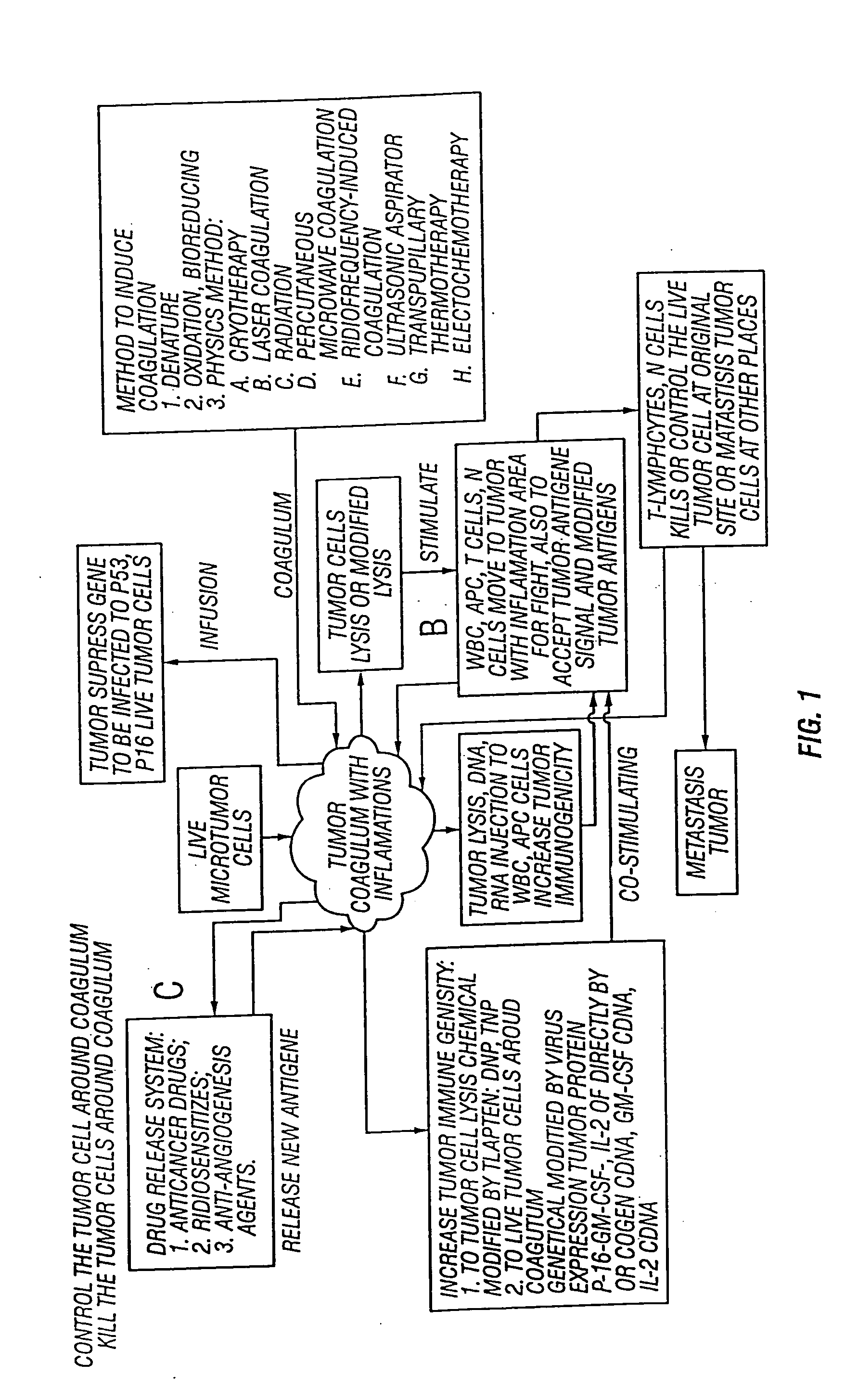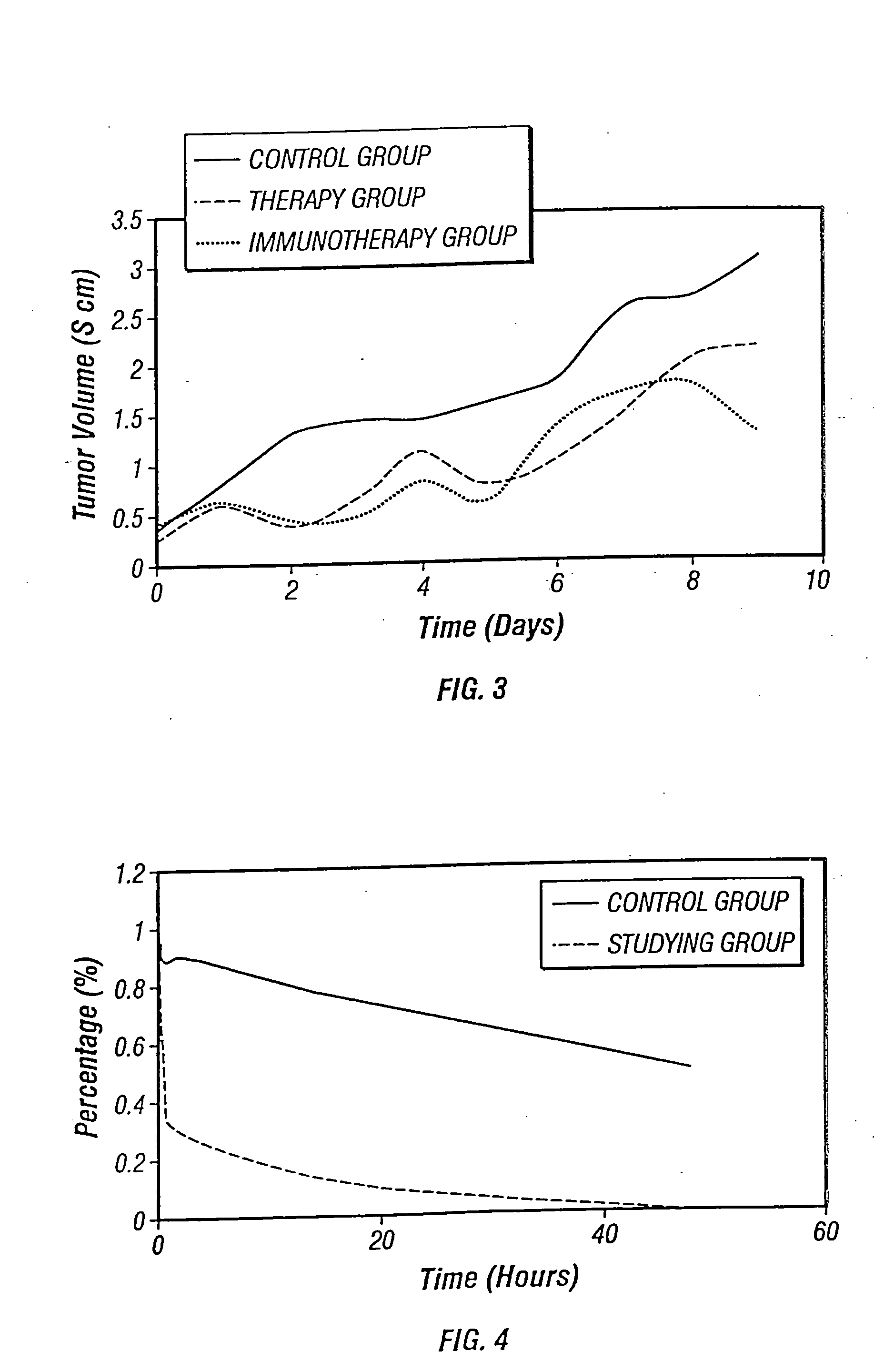Combinations and methods for treating neoplasms
a technology for neoplasms and combinations, applied in the field of compositions and methods for treating neoplasms, can solve the problems of no longer suitable for effective surgical treatment, no longer effective in treating patients, and ineffective other therapies, so as to reduce the neoplasm metastasis rate, improve radiation therapy efficacy, and facilitate surgery removal
- Summary
- Abstract
- Description
- Claims
- Application Information
AI Technical Summary
Benefits of technology
Problems solved by technology
Method used
Image
Examples
example 1
Treatment with Chemotherapy
[0213] Thirty one advanced stage IV liver cancer patients were treated using the presently contemplated in-situ vaccination therapy. There are 24 male and 7 female patients in this group with an age range from 30 to 70 years old. Twenty patients have primary liver cancer: eighteen of these twenty patients have abnormal liver function; fourteen of these twenty patients have ascites; and all twenty cases have recent weight loss. The remaining eleven of the cancer patients have secondary liver cancer: five patients have liver metastasis cancer from the esophagus, two have liver metastasis cancer from the stomach, three have liver metastasis cancer from the colon and one has liver metastasis cancer from the lungs. Prior to the procedure, patients were given a mild sedative or painkiller. Patients were calmed thoroughly and were also monitored by modern medical imaging. With local anesthesia, percutaneous puncture was administered directly into the tumor using...
example 2
Treatment with Radiotherapy
[0221] Twenty esophagus carcinoma patients were treated with the contemplated methods with radiotherapy. The esophagus X-ray film showed that ten patients had middle of esophagus 3 to 4 cm tumor, another ten had 5 to 8 cm tumor burden. The clinical diagnosis was middle esophagus carcinoma. One patient was at Ia stage, T2N0M0, PKS score was 80. Another patient was at IIa, T3N0M0, with a cellular pathology diagnosis of squamocellular carcinoma. These patients were treated under esophagus endoscope direction. Needle was injected into tumor and the composition containing ethanol, H2O2, hapten and anticancer drug AraC was injected followed with radiation therapy in a dose of 60 Gy / 30 times / 6 weeks. Esophagus X-ray showed that the tumor disappeared. For one year and five months after the treatment, the patients have been in good condition and no local tumor recovery has been observed.
[0222] Sixteen patients with late stages of lung carcinoma were treated with ...
example 3
Treatment of Ovarian Carcinoma
[0223] One 56 year old female ovarian carcinoma patient had a surgery 8 years ago. The patient had a big mass in the lower abdomen before the treatment. Sonic-imaging showed a 5×4.1×3 cm size. The patient received chemotherapy that resulted in tumor growth. The patient was treated with composition containing ethanol, H2O2, anticancer drug AraC and hapten. Two weeks later, tumor size reduced to 3.4×3.5×2 cm. The patient have been feeling better and has normal blood cell counts.
PUM
| Property | Measurement | Unit |
|---|---|---|
| molecular weights | aaaaa | aaaaa |
| molecular weights | aaaaa | aaaaa |
| concentration | aaaaa | aaaaa |
Abstract
Description
Claims
Application Information
 Login to View More
Login to View More - R&D
- Intellectual Property
- Life Sciences
- Materials
- Tech Scout
- Unparalleled Data Quality
- Higher Quality Content
- 60% Fewer Hallucinations
Browse by: Latest US Patents, China's latest patents, Technical Efficacy Thesaurus, Application Domain, Technology Topic, Popular Technical Reports.
© 2025 PatSnap. All rights reserved.Legal|Privacy policy|Modern Slavery Act Transparency Statement|Sitemap|About US| Contact US: help@patsnap.com



